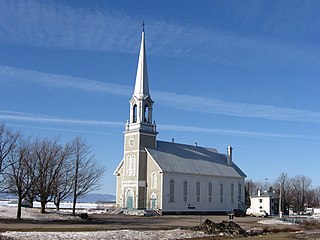
La Durantaye is a parish municipality in the Bellechasse Regional County Municipality in the Chaudière-Appalaches administrative region of Quebec.
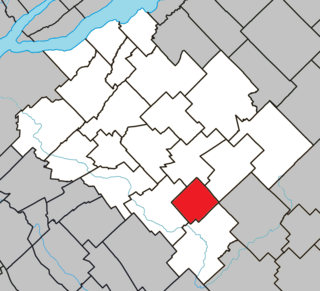
Saint-Nazaire-de-Dorchester is a parish municipality of 400 people in the Bellechasse Regional County Municipality, Quebec, part of the Chaudière-Appalaches administrative region. It is the least populous municipality in Bellechasse.

Saint-Léon-de-Standon is a parish municipality of about 1,000 people in the Bellechasse Regional County Municipality in the Chaudière-Appalaches region of Quebec. The Etchemin River goes through the municipality.
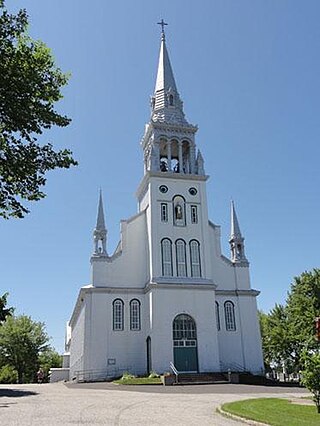
Saint-Philémon is a parish municipality of about 700 people in the Bellechasse Regional County Municipality in the Chaudière-Appalaches administrative region of Quebec.

Saint-Jules is a parish municipality in the Beauce-Centre Regional County Municipality in the Chaudière-Appalaches region of Quebec, Canada. Its population was 547 as of the Canada 2021 Census. It is named after Pope Julius I.

Saint-Séverin is a parish in the Beauce-Centre Regional County Municipality in Quebec, Canada. It is part of the Chaudière-Appalaches region and the population is 300 as of 2021. It is named after Reverend Édouard-Séverin Fafard, founder of the parish in 1864.

Notre-Dame-du-Sacré-Cœur-d'Issoudun is a parish municipality in the Lotbinière Regional County Municipality in the Chaudière-Appalaches region of Quebec, Canada. Its population is 869 as of the Canada 2011 Census. It is simply known as Issoudun, given the length of the official name.
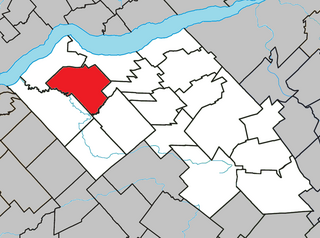
Saint-Édouard-de-Lotbinière is a parish municipality in the Lotbinière Regional County Municipality in the Chaudière-Appalaches region of Quebec, Canada. Its population is 1,248 as of the Canada 2011 Census. It is named after Édouard Faucher, founder and first priest of the parish, and René-Louis Chartier de Lotbinière, first owner of the seigneurie in which Saint-Édouard lay.

Saint-Narcisse-de-Beaurivage is a parish municipality in the Lotbinière Regional County Municipality in the Chaudière-Appalaches region of Quebec, Canada. Its population is 1,152 as of the Canada 2021 Census. It was named after the Narcisse Dionne, an early benefactor of the parish. Beaurivage is associated to the seigneurie of Beaurivage, also known as Saint-Gilles.

Sainte-Apolline-de-Patton is a parish municipality of 542 people in Montmagny Regional County Municipality in the Chaudière-Appalaches region of Quebec.

Saint-Hilaire-de-Dorset is a parish municipality in the Beauce-Sartigan Regional County Municipality in the Chaudière-Appalaches region of Quebec, Canada.

Notre-Dame-des-Pins is a parish municipality in the Beauce-Sartigan Regional County Municipality in the Chaudière-Appalaches region of Quebec, Canada. Its population is 1,812 as of the Canada 2021 Census.
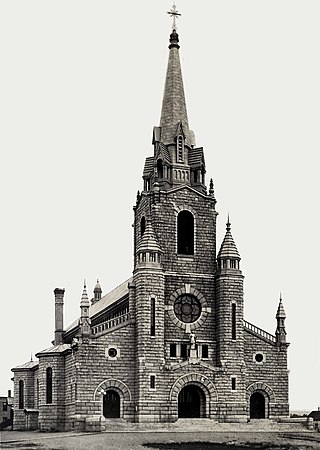
The city of Disraeli is located in the Municipalité régionale de comté des Appalaches in Quebec, Canada. It is part of the Chaudière-Appalaches region and the population is 2,570 as of 2009. It was named after British statesman and writer Benjamin Disraeli.
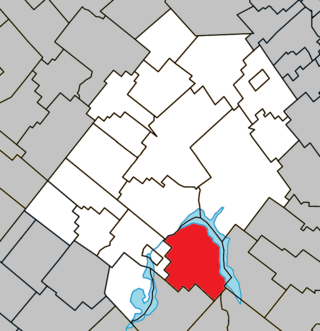
Sainte-Praxède is a parish municipality located in Les Appalaches Regional County Municipality in the Chaudière-Appalaches region of Quebec, Canada. Its population was 351 as of the Canada 2021 Census. It was named after Catholic saint Praxedes.

Saint-Jacques-le-Majeur-de-Wolfestown is a parish municipality in Les Appalaches Regional County Municipality in the Chaudière-Appalaches region of Quebec, Canada. Its population is 189 as of the Canada 2011 Census.

Sacré-Cœur-de-Jésus is a parish municipality located in Les Appalaches Regional County Municipality in the Chaudière-Appalaches region of Quebec, Canada. Its population was 564 as of the Canada 2011 Census.

Saint-Cyprien is a parish in the Les Etchemins Regional County Municipality in Quebec, Canada. It is part of the Chaudière-Appalaches region and the population is 490 as of 2016. It is named after Christian martyr Cyprian.

Saint-Camille-de-Lellis is a parish in the Les Etchemins Regional County Municipality in Quebec, Canada. It is part of the Chaudière-Appalaches region and the population is 737 as of the Canada 2021 Census. It is named after Saint Camillus de Lellis, but also commemorates Reverend Camille-Stanislas Brochu, first priest of the parish.

Sainte-Sabine is a parish municipality in Les Etchemins Regional County Municipality in the Chaudière-Appalaches region of Quebec, Canada. Its population is 386 as of the Canada 2011 Census.
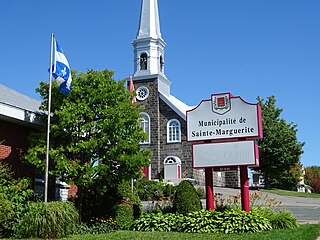
Sainte-Marguerite is a parish municipality in La Nouvelle-Beauce Regional County Municipality in the Chaudière-Appalaches region of Quebec, Canada. Its population is 1,107 as of the Canada 2011 Census. It is named after Marguerite Marcoux, who gave part of the land she owned in 1830 for the construction of a church.





















